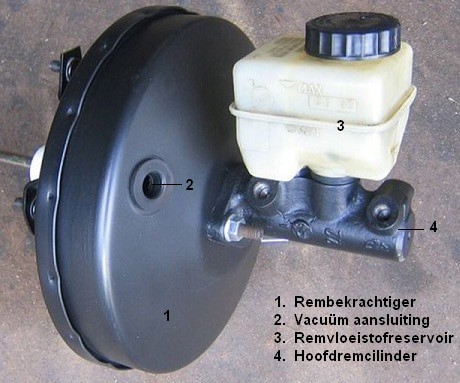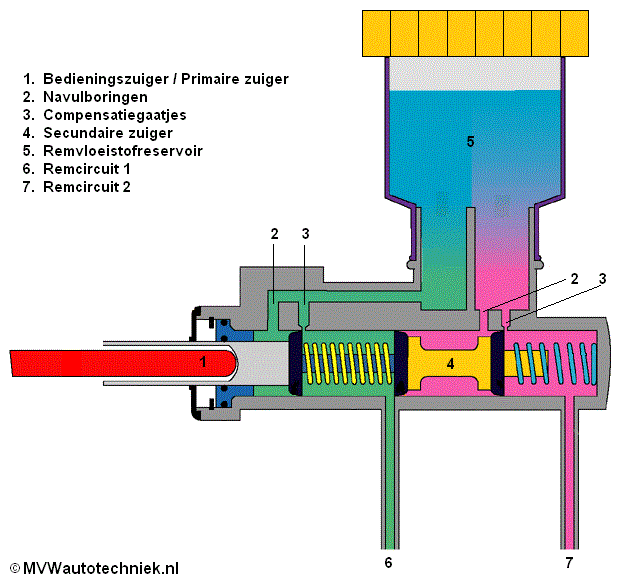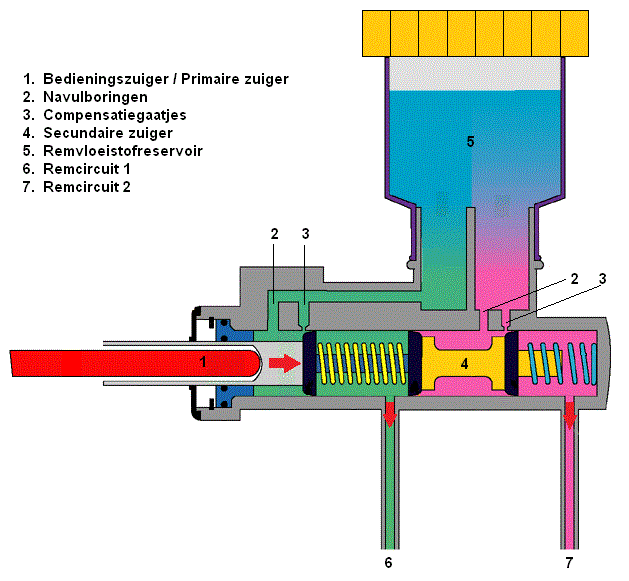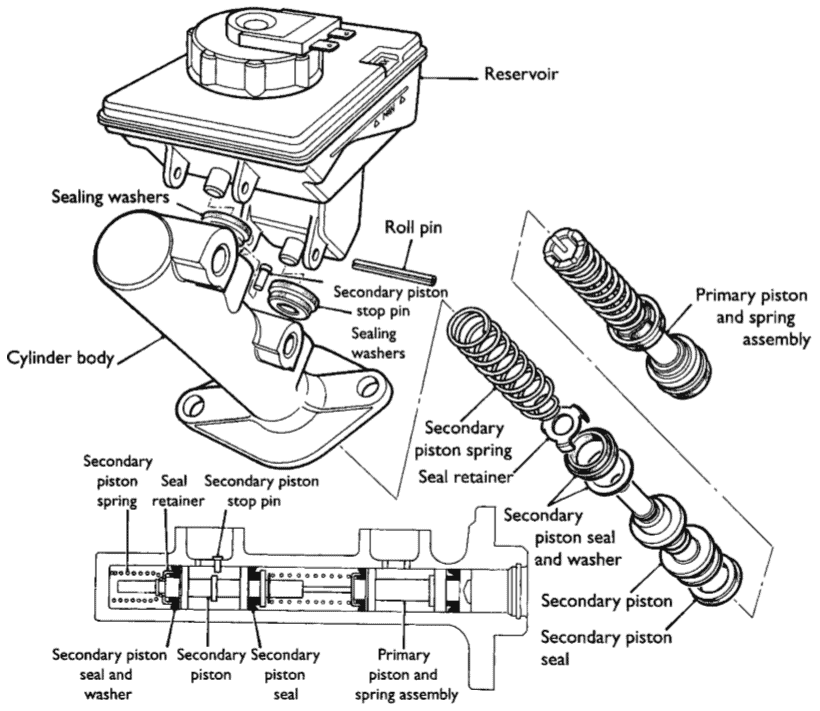Subjects:
- Tandem Master Cylinder
- Operation
- Defects
Tandem Master Cylinder:
The master cylinder is mounted on the brake booster. At the top is the brake fluid reservoir that ensures the supply and discharge of the brake fluid. When the brake pedal is depressed, a fluid pressure is built up in the master cylinder via the vacuum effect in the brake booster. From the master cylinder, the pressure moves through the brake hoses and brake lines to the wheel brake cylinders.
Today we only use the Tandem master cylinders. This divides the braking system into 2 braking circuits:
- One circuit for the front wheels and one for the rear wheels.
- Diagonally separated braking circuits; one circuit operates the left front wheel and the right rear wheel. The second circuit then operates the right front wheel and the left rear wheel.
- When using disc brakes with multiple pistons per caliper, each caliper can be operated by 2 separate circuits.

The image below shows a vehicle with a diagonally separated brake circuit. The red line indicates the brake circuit of the left front wheel and the right rear wheel. The blue line indicates the front right and rear left.

Operation:
The tandem master cylinder is shown in the illustration in rest position. So now there is no braking. The springs of the primary and secondary pistons push both the actuating piston and the primary piston to the left, so that the space at the bores 3 is freed up. The brake fluid reservoir is divided into 2 separate parts at the bottom. When a part of the brake system leaks and one brake circuit becomes empty, it does not affect the other brake circuit. The braking effect is maintained via the other circuit.

While braking:
The control piston (1) moves to the right. Since liquid is not compressible, the liquid also displaces the secondary piston. The moment there is a leak in the primary brake circuit, there is mechanical contact between the primary and secondary pistons. When the primary cups are past the compensation holes (3) (as shown in the picture), pressure builds up. The brake fluid is pressed to the wheel brake cylinders, which activates the brakes. The further actuating piston 1 is moved to the right, the higher the brake pressure becomes. Both pistons move to the right simultaneously, because the (left) spring behind the primary piston has a greater preload than the (right) spring next to the secondary piston. When braking is stopped, the control piston moves to the left again and both springs push the primary and secondary pistons back to the home position.

The image below shows an exploded view of the components in the master cylinder with the brake fluid reservoir.

Defects:
Failure of the brake system can be caused by defects in the master cylinder. Two situations are described below which are characteristic of a defect in the master cylinder.
- Defect 1: When the brake pedal drops deeper and deeper while the brake pedal is pressed with a constant force, it appears as if there is a loss of pressure in the system. The first thing you would think of is a leak. If no leakage can be found, but the brake pedal continues to drop, the problem can be found in the master cylinder. The primary cup, which seals the space between the compensating holes (3) and the brake circuit, may leak. The brake fluid is forced into the brake circuit by the primary or secondary piston under pressure. Due to this leaking cup, the fluid flows slowly through the compensation hole back to the brake fluid reservoir.
Replacing the brake cups solves the problem, but usually the complete master cylinder is replaced. - Fault 2: When the control piston seal (on the far left in the illustration) is leaking, brake fluid from the master cylinder may flow directly into the brake booster. There is a risk that the function of the brake booster will be affected by this and that the primary brake circuit (1) will lose the brake pressure due to a brake fluid level that is too low. In the event that all brake fluid has leaked out of the primary brake circuit (with a diagonally separated system and the primary brake circuit only brakes the left front wheel and the right rear wheel), the secondary brake circuit will absorb all braking forces. Because the secondary brake circuit then only brakes the right front wheel and the left rear wheel, the braking effect will be a lot less. But the most important thing is that the car can still be brought to a stop.
